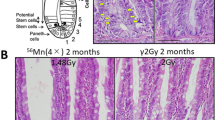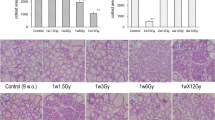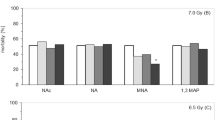Abstract
WHILE it is thought that X-radiation in vivo does not produce any changes in the properties of deoxyribonucleic acid (DNA) which are associated with H bonding1, alterations in its structure are suggested from differences in fractionation pattern on ECTEOLA2,3 and from the diminished capacity of nuclei isolated after irradiation in vivo to act as templates for DNA synthesis4. The validity of the chromatographical evidence has been questioned for normal animals by Kondo and Osawa5 and after irradiation6,7, due to our ignorance of the means by which fractionation on ECTEOLA is attained and because of the possibility that the differences found between DNA from control and irradiated animals could be due to the action of DNases which are known to be activated in thymus after X-radiation. In view of these uncertainties, it was decided to extend our earlier observations on thymus DNA to regenerating rat liver. This tissue is advantageous since it is possible to irradiate at a known period in the mitotic cycle, and because in normal rat liver activation of DNases post-irradiation is much less marked than in thymus8. DNA was isolated by Kirby's method9, which would reduce to a minimum DNase action during the isolation.
This is a preview of subscription content, access via your institution
Access options
Subscribe to this journal
Receive 51 print issues and online access
$199.00 per year
only $3.90 per issue
Buy this article
- Purchase on Springer Link
- Instant access to full article PDF
Prices may be subject to local taxes which are calculated during checkout
Similar content being viewed by others
References
Ord, M. G., and Stocken, L. A., in de Hevesy, G., Forssberg, A., and Abbatt, J. D., Adv. Radiobiol., 65 (Oliver and Boyd, Ltd., Edinburgh, 1957).
Harrington, H., Proc. Fifth Intern. Cong. Biochem., 24, 67, 1342 (1961).
Ord, M. G., and Stocken, L. A., Biochim. Biophys. Acta, 37, 352 (1960).
Van Lancker, J. L., Biochim. Biophys. Acta, 45, 57, 63 (1960).
Kondo, N., and Osawa, S., Nature, 183, 1602 (1959).
Bacq, Z. M., and Alexander, P., Fundamentals of Radiobiology, second ed., 206 (Pergamon Press, Ltd., Oxford, 1961).
Kuzin, A. M., in Symp. on Initial Effects of Ionizing Radiations on Living Cells, Unesco, Moscow (1960).
Okada, S., Gordon, E. R., King, R., and Hempelmann, L. H., Arch. Biochem. Biophys., 70, 469 (1957).
Kirby, K. S., Biochem. J., 66, 495 (1957).
Bendich, A., Pahl, H. B., Korngold, G. C., Rosenkranz, H. S., and Fresco, J. R., J. Amer. Chem. Soc., 80, 3949 (1958).
Rosenkranz, H. S., and Bendich, A., J. Amer. Chem. Soc., 81, 6255 (1959).
Marmur, J., and Doty, P., Nature, 183, 1427(1959)
Author information
Authors and Affiliations
Rights and permissions
About this article
Cite this article
FOSTER, R., ORD, M. Alterations in Deoxyribonucleic Acid from Regenerating Rat Liver after X-radiation in vivo. Nature 194, 883–884 (1962). https://doi.org/10.1038/194883a0
Issue Date:
DOI: https://doi.org/10.1038/194883a0
Comments
By submitting a comment you agree to abide by our Terms and Community Guidelines. If you find something abusive or that does not comply with our terms or guidelines please flag it as inappropriate.



